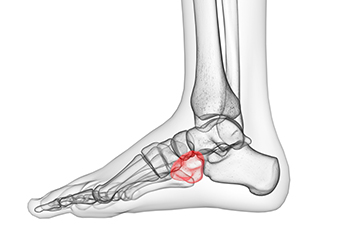Connect With Us
Blog
Items filtered by date: May 2024
Get Proper Treatment for Ankle Injuries
Complications of Peripheral Neuropathy
 Peripheral neuropathy results from damage to the peripheral nerves, which are responsible for sending information from the brain and spinal cord to the rest of the body. This condition often results in tingling, numbness, and pain in the affected areas, typically the hands and feet. Due to high blood sugar levels common in diabetes, people with this disease are more prone to peripheral neuropathy and the associated lack of sensation in the feet. This loss of feeling means that injuries, pressure sores, or other foot problems may go unnoticed. Without prompt and proper care, such untreated injuries can develop into diabetic foot ulcers, serious wounds that heal very slowly due to impaired circulation. If these ulcers become infected and treatment is not working, the ulcer can progress to gangrene, which involves the death of body tissue. This sometimes necessitates amputation to prevent further health complications. Regular check-ups with a podiatrist, or foot doctor, can help manage peripheral neuropathy and prevent severe complications. If you have peripheral neuropathy, it is suggested that you add a podiatrist to your regular care team.
Peripheral neuropathy results from damage to the peripheral nerves, which are responsible for sending information from the brain and spinal cord to the rest of the body. This condition often results in tingling, numbness, and pain in the affected areas, typically the hands and feet. Due to high blood sugar levels common in diabetes, people with this disease are more prone to peripheral neuropathy and the associated lack of sensation in the feet. This loss of feeling means that injuries, pressure sores, or other foot problems may go unnoticed. Without prompt and proper care, such untreated injuries can develop into diabetic foot ulcers, serious wounds that heal very slowly due to impaired circulation. If these ulcers become infected and treatment is not working, the ulcer can progress to gangrene, which involves the death of body tissue. This sometimes necessitates amputation to prevent further health complications. Regular check-ups with a podiatrist, or foot doctor, can help manage peripheral neuropathy and prevent severe complications. If you have peripheral neuropathy, it is suggested that you add a podiatrist to your regular care team.
Neuropathy
Neuropathy can be a potentially serious condition, especially if it is left undiagnosed. If you have any concerns that you may be experiencing nerve loss in your feet, consult with one of our doctors from Advanced Podiatry. Our doctors will assess your condition and provide you with quality foot and ankle treatment for neuropathy.
What Is Neuropathy?
Neuropathy is a condition that leads to damage to the nerves in the body. Peripheral neuropathy, or neuropathy that affects your peripheral nervous system, usually occurs in the feet. Neuropathy can be triggered by a number of different causes. Such causes include diabetes, infections, cancers, disorders, and toxic substances.
Symptoms of Neuropathy Include:
- Numbness
- Sensation loss
- Prickling and tingling sensations
- Throbbing, freezing, burning pains
- Muscle weakness
Those with diabetes are at serious risk due to being unable to feel an ulcer on their feet. Diabetics usually also suffer from poor blood circulation. This can lead to the wound not healing, infections occurring, and the limb may have to be amputated.
Treatment
To treat neuropathy in the foot, podiatrists will first diagnose the cause of the neuropathy. Figuring out the underlying cause of the neuropathy will allow the podiatrist to prescribe the best treatment, whether it be caused by diabetes, toxic substance exposure, infection, etc. If the nerve has not died, then it’s possible that sensation may be able to return to the foot.
Pain medication may be issued for pain. Electrical nerve stimulation can be used to stimulate nerves. If the neuropathy is caused from pressure on the nerves, then surgery may be necessary.
If you have any questions, please feel free to contact our offices located in Needham, Norwood, and Hanover, MA . We offer the newest diagnostic and treatment technologies for all your foot care needs.
Cuboid Syndrome and Other Cuboid Injuries
 Cuboid syndrome occurs when the cuboid bone, located on the outer side of the midfoot, partially dislocates. This condition typically results from injury or repetitive strain that disrupts the alignment and stability of the cuboid bone. The hallmark symptom of cuboid syndrome is pain on the lateral side of the foot, especially when weight is placed on the foot or when pushing off the toes. Other symptoms can include tenderness, swelling, and difficulty walking. Athletes or people with poor foot biomechanics are more prone to getting cuboid syndrome. Another type of cuboid injury, cuboid fractures, are less common. Fractures result from direct trauma or severe force to the cuboid bone, leading to more acute and localized pain, significant swelling, and bruising. Both conditions require proper medical assessment and treatment. For cuboid syndrome, treatment might involve various techniques, such as manipulation to realign the bone, taping to stabilize it, and orthotics to correct biomechanical issues. For fractures, immobilization with a cast or boot and possibly surgery may be necessary. A podiatrist, or foot doctor, can diagnose these conditions through clinical evaluation and imaging studies like X-rays. They can also provide the appropriate management techniques to alleviate pain and restore function. If you suspect an injury to the cuboid bone in the foot, it is suggested that you make an appointment with a podiatrist as soon as possible.
Cuboid syndrome occurs when the cuboid bone, located on the outer side of the midfoot, partially dislocates. This condition typically results from injury or repetitive strain that disrupts the alignment and stability of the cuboid bone. The hallmark symptom of cuboid syndrome is pain on the lateral side of the foot, especially when weight is placed on the foot or when pushing off the toes. Other symptoms can include tenderness, swelling, and difficulty walking. Athletes or people with poor foot biomechanics are more prone to getting cuboid syndrome. Another type of cuboid injury, cuboid fractures, are less common. Fractures result from direct trauma or severe force to the cuboid bone, leading to more acute and localized pain, significant swelling, and bruising. Both conditions require proper medical assessment and treatment. For cuboid syndrome, treatment might involve various techniques, such as manipulation to realign the bone, taping to stabilize it, and orthotics to correct biomechanical issues. For fractures, immobilization with a cast or boot and possibly surgery may be necessary. A podiatrist, or foot doctor, can diagnose these conditions through clinical evaluation and imaging studies like X-rays. They can also provide the appropriate management techniques to alleviate pain and restore function. If you suspect an injury to the cuboid bone in the foot, it is suggested that you make an appointment with a podiatrist as soon as possible.
Cuboid syndrome, also known as cuboid subluxation, occurs when the joints and ligaments near the cuboid bone in the foot become torn. If you have cuboid syndrome, consult with one of our doctors from Advanced Podiatry. Our doctors will assess your condition and provide you with quality foot and ankle treatment.
Cuboid syndrome is a common cause of lateral foot pain, which is pain on the outside of the foot. The condition may happen suddenly due to an ankle sprain, or it may develop slowly overtime from repetitive tension through the bone and surrounding structures.
Causes
The most common causes of cuboid syndrome include:
- Injury – The most common cause of this ailment is an ankle sprain.
- Repetitive Strain – Tension placed through the peroneus longus muscle from repetitive activities such as jumping and running may cause excessive traction on the bone causing it to sublux.
- Altered Foot Biomechanics – Most people suffering from cuboid subluxation have flat feet.
Symptoms
A common symptom of cuboid syndrome is pain along the outside of the foot which can be felt in the ankle and toes. This pain may create walking difficulties and may cause those with the condition to walk with a limp.
Diagnosis
Diagnosis of cuboid syndrome is often difficult, and it is often misdiagnosed. X-rays, MRIs and CT scans often fail to properly show the cuboid subluxation. Although there isn’t a specific test used to diagnose cuboid syndrome, your podiatrist will usually check if pain is felt while pressing firmly on the cuboid bone of your foot.
Treatment
Just as the range of causes varies widely, so do treatments. Some more common treatments are ice therapy, rest, exercise, taping, and orthotics.
If you have any questions, please feel free to contact our offices located in Needham, Norwood, and Hanover, MA . We offer the newest diagnostic and treatment technologies for all your foot care needs.
Causes and Symptoms of Broken Toes

Broken toes, though often perceived as minor injuries, can cause significant discomfort and inconvenience. Common causes include trauma from stubbing or dropping heavy objects on the toes, as well as sports-related injuries and accidents. Symptoms of a broken toe typically include pain, swelling, bruising, and difficulty bearing weight on the affected foot. In severe cases, the toe may appear misaligned or visibly deformed. Unlike more complex fractures, diagnosing a broken toe may not always require imaging tests. However, seeking medical attention from a podiatrist is advisable to confirm the diagnosis and rule out any complications. Treatment for broken toes typically involves rest, elevation, and immobilization to promote healing and alleviate pain. In some instances, a podiatrist may recommend buddy taping or wearing a splint or walking boot to stabilize the toe during recovery. Having a broken toe can negatively impact daily activities. If you have broken your toe, it is suggested that you seek advice about proper treatment from a podiatrist as quickly as possible to avoid potential complications in healing.
A broken toe can be very painful and lead to complications if not properly fixed. If you have any concerns about your feet, contact one of our doctors from Advanced Podiatry. Our doctors will treat your foot and ankle needs.
What to Know About a Broken Toe
Although most people try to avoid foot trauma such as banging, stubbing, or dropping heavy objects on their feet, the unfortunate fact is that it is a common occurrence. Given the fact that toes are positioned in front of the feet, they typically sustain the brunt of such trauma. When trauma occurs to a toe, the result can be a painful break (fracture).
Symptoms of a Broken Toe
- Throbbing pain
- Swelling
- Bruising on the skin and toenail
- The inability to move the toe
- Toe appears crooked or disfigured
- Tingling or numbness in the toe
Generally, it is best to stay off of the injured toe with the affected foot elevated.
Severe toe fractures may be treated with a splint, cast, and in some cases, minor surgery. Due to its position and the pressure it endures with daily activity, future complications can occur if the big toe is not properly treated.
If you have any questions please feel free to contact our offices located in Needham, Norwood, and Hanover, MA . We offer the newest diagnostic and treatment technologies for all your foot and ankle needs.
Consulting a Podiatrist for a Foot Fracture

A broken foot, or foot fracture, occurs when one or more bones in the foot are cracked or broken. This can happen due to trauma from accidents, falls, sports injuries, or from repetitive stress over time. Fractures are categorized as open, when the bone breaks through the skin, or closed, where the skin remains intact. Treatment for a broken foot depends on the location and severity of the fracture. It may involve immobilization with a cast or splint, rest, elevation, and sometimes surgery to realign the bones and facilitate proper healing. If you have broken your foot, it is suggested that you schedule an appointment with a podiatrist who can provide expert assessment, develop a tailored treatment plan, and offer ongoing care to ensure optimal recovery and long-term foot health.
A broken foot requires immediate medical attention and treatment. If you need your feet checked, contact one of our doctors from Advanced Podiatry. Our doctors can provide the care you need to keep you pain-free and on your feet.
Broken Foot Causes, Symptoms, and Treatment
A broken foot is caused by one of the bones in the foot typically breaking when bended, crushed, or stretched beyond its natural capabilities. Usually the location of the fracture indicates how the break occurred, whether it was through an object, fall, or any other type of injury.
Common Symptoms of Broken Feet:
- Bruising
- Pain
- Redness
- Swelling
- Blue in color
- Numbness
- Cold
- Misshapen
- Cuts
- Deformities
Those that suspect they have a broken foot shoot seek urgent medical attention where a medical professional could diagnose the severity.
Treatment for broken bones varies depending on the cause, severity and location. Some will require the use of splints, casts or crutches while others could even involve surgery to repair the broken bones. Personal care includes the use of ice and keeping the foot stabilized and elevated.
If you have any questions please feel free to contact our offices located in Needham, Norwood, and Hanover, MA . We offer the newest diagnostic and treatment technologies for all your foot and ankle needs.

